| 1 | Boomslang |
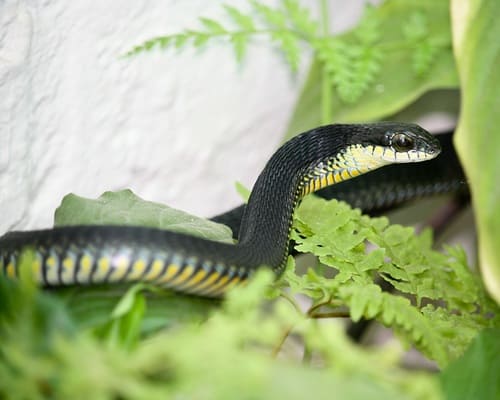
A garden is supposed to contain flowers, deck chairs on patios, rows of tomatoes, and maybe a greenhouse. But something you’re just as likely to have if you live in Africa is a boomslang.
This is undoubtedly one of the deadliest snakes to show up in gardens worldwide. Its LD50 toxicity rating is 0.07mg, almost matching a black mamba’s 0.05mg. Its venom is hemotoxic to the extreme, causing tiny cuts to burst open like an uncorked dam, and internal organs to start disintegrating. Luckily, they struggle to inject venom due to awkwardly positioned fangs, and they have a small yield of 1.6-8mg per bite.
Either way, boomslangs are a risk in gardens because they love to disguise themselves among greenery, such as in bushes. They’re a tree snake which prefers thinly spread trees to dense forests, typically with green bushes and vegetation below. This makes a garden perfect for them. Playing ball, throwing it into a bush, and sticking your arm in could easily end in a boomslang bite. Rumours state that they love to leap onto people’s heads, and every element of their appearance is tailor made for camouflage in greenery. Boomslangs inhabit over 15 countries in sub-Saharan Africa, from Ghana to Zimbabwe to Kenya.
| 2 | Common bronzeback |
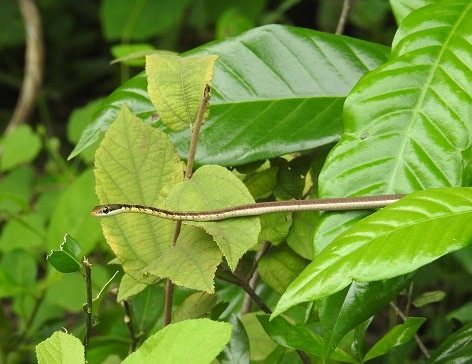
A thin snake that rests on low branches and bushes, with a light weight in order to not snap them. While the painted bronzeback is in total control of Thailand, common bronzebacks (Dendrelaphis tristis) rule India.
Common bronzebacks are mildly venomous, a venom which is unresearched, but probably causes a mild swelling at best (or worst). This is a common sight in rural gardens, particularly in bushes, rather than hiding under leaves like a kukri snake. Common bronzebacks can just pass through, from garden to garden, or perhaps stay a while. They prey on reptiles like agamids and geckos, and inhabit all of India except the Himalaya and northwest.
The scientific reason is that house gardens are a perfect replica of their natural habitat. Common bronzebacks naturally live in forests, but particularly forest edges, with a mixture of bushes, grass, thinner tree clumps and maybe a rural trail. Dendrelaphis tristis likes areas of mixed vegetation, not vast sweeping vistas of forests stretching as far as the eye can see. When a retired Indian man builds his dream garden, proudly applying the finishing touches, he has no idea that he’s created the perfect haven for this mildly venomous snake.
| 3 | Central American coral snake |

Mainly a forest snake, but more flexible than the average coral snake, allowing them to appear in plantations and gardens. Beware: this is a dangerously venomous species, reaching a level far beyond the common bronzeback. Central American coral snakes (Micrurus nigrocinctus) have powerfully neurotoxic venom which can trigger paralysis and respiratory failure.
In fact, the danger may be higher in gardens. In forests, their bright colours stand out, and you can walk past harmlessly. In gardens, they lurk under cover, and can bite your fingers as you accidentally scoop them up. Micrurus nigrocinctus ranges from Guatemala to western Colombia.
If your home is in a rural area directly adjacent to a forest, the risk dramatically increases. Central American coral snakes prefer forests, but regularly stray to their bushy outskirts. Likewise for Steindachner’s coral snake in Ecuador or the small coral snake of Trinidad. If your garden is next to a forest, then you’ll be vulnerable to the spillage effect. Even town gardens aren’t free from these dangerous serpents, as Venezuelan coral snakes have found been found in Caracas.
In Perth, Australia, venomous dugites invade suburban gardens in search of black rats. The only gardens free from any snakes are a billionaire’s artificial garden at the top of a skyscraper, and even then, a golden tree snake could gain access by hiding in a flowerpot crate.
| 4 | Madagascan ground boa |
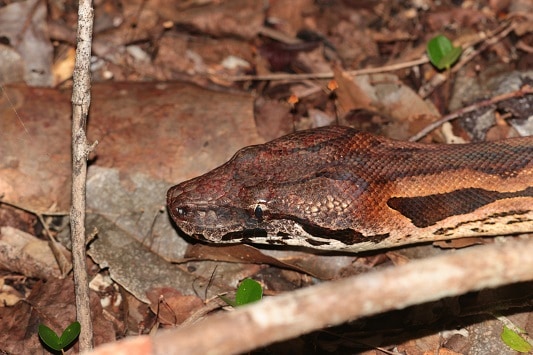
The thick, crushing constrictor of northern Madagascar, found in woodlands with an abundance of dried leaves to blend with. This species feeds on mammals, like brown lemurs and invasive rats. The heaviest Madagascar snake ever recorded was found in a garden – the grounds of Anjajavy l’Hôtel in northern Madagascar. This was a Madagascar ground boa dubbed “Big George”, which measured 270cm and weighed 8.2kg.
This had lived peacefully among the guests and staff for years, the owner told the scientists, thus proving that a sudden Madagascan ground boa in your garden isn’t cause for panic. There’s no reason to be concerned, even if you’re stepping over them every morning. It could become the unofficial family pet, as long as it doesn’t devour the family cat in a demented attempt to take its place as the official.
Madagascan ground boas have excellent camouflage, even spreading to their eyes. They blend so effectively that despite their thick tree trunk of a body, they might be invisible at the back of your Madagascan garden.
| 5 | Yellow-striped trinket snake |
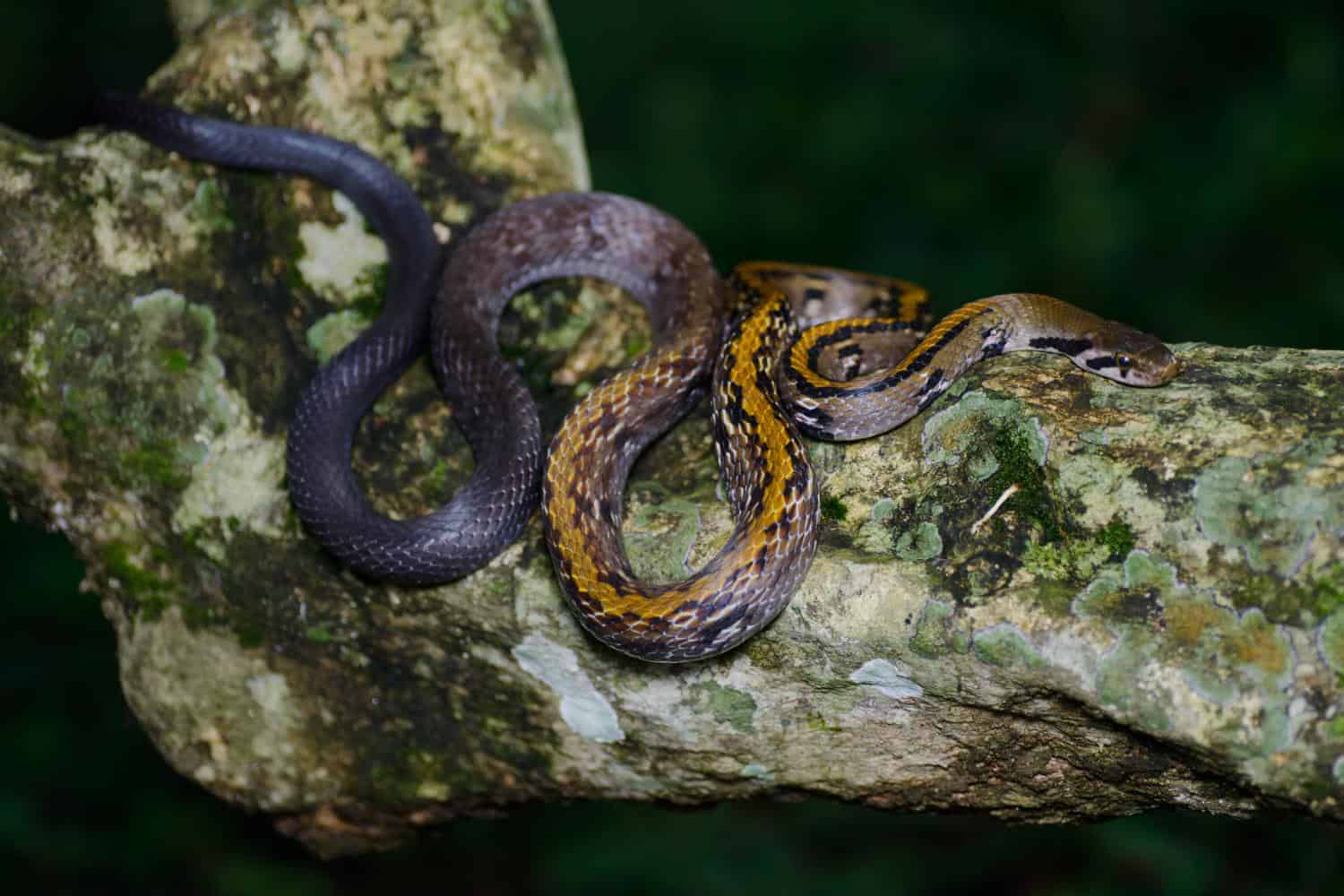
A Thai cousin of the Indian trinket snake found commonly in rice paddies. This is an energetic species which reaches 180cm, with no venom, yet a jagged pair of fangs. They’re multi-skilled, swimming and climbing trees with aplomb.
Yellow-striped trinket snakes can appear in forests and fields alike, and gardens certainly aren’t off limits, particularly near Phuket and in peninsular Malaysia where they’re common. If there’s a mixture of juicy vegetation and prey, then Coelognathus flavolineatus will happily settle into a garden, or add it to a list of locations it returns to again and again, on its weekly tour of the Thai countryside.
The yellow-striped trinket snake could shock you in many ways. You could be adding an armful of grass cuttings to the pile, only for a serpent head to pop out. You could be picking tomatoes when a Coelognathus flavolineatus falls off the adjacent tree. You could be playing frisbee with your dog, and get bitten on the hand while retrieving it from a bush. The possibilities are endless with this garden loving snake. Yellow-striped trinket snakes also take refuge in your shed, causing you to open the door, hear a hiss, and instantly close and lock it.
| 6 | Deuve’s kukri snake |
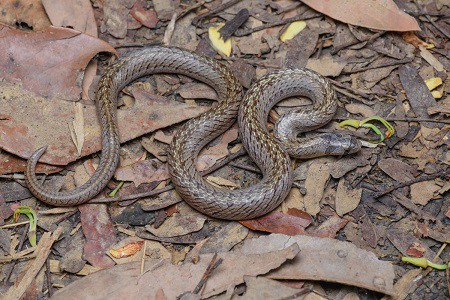
A Vietnamese species which was only confirmed as independent in 2016, from its cousin the striped kukri snake. Deuve’s kukri snake inhabits national parks like Cat Tien near Ho Chi Mingh City, including forests, but also back gardens, where they stick to the ground. Oligodon deuvei has dull colours, with a yellow-speckled stripe down its spine. A pond in your garden is a surefire magnet for Deuve’s kukri snake, if it’s teaming with tasty frogs. This species is non-venomous, but with their razor sharp fangs, this doesn’t prevent them from doing damage.
If you spot Oligodon deuvei in your garden, it’s not just a fun event, but an opportunity. This is a species with large gaps in the scientific record – diet, predators, time spent on branches. Grab a notepad, a cup of tea, and you could be the first person on earth to became an expert on Deuve’s kukri snake.
For example, California kingsnakes were observed in 2019 in a 4-snake wrestling match, in a scientist’s own back garden. Who knows what you could observe with Oligdon deuvei, or any snake on this list.
| 7 | Common garter snake |
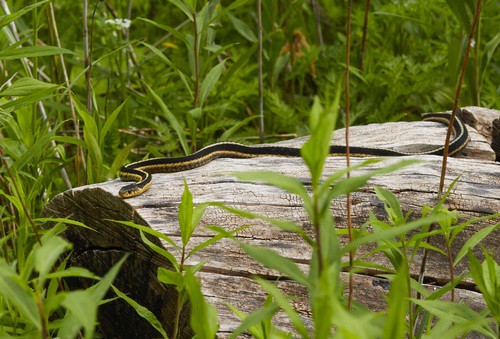
This US species measures 80-100cm, and its name is theorised to originate from the German word of Garten for garden. Common garter snakes live in streams and moist countryside fields, but regularly pop up on people’s back lawns, as they’re a perfect match. This is a harmless species which won’t murder you while you sit on your new garden bench. They inhabit every lower US state except Arizona, and are a garden snake candidate virtually anywhere, including southern Canada.
Thamnophis sirtalis is lured to people’s gardens by the earthworms, slugs and leeches living there. These form a large portion of the common garter snake’s diet, with larger meals including frogs. The sight of them slithering openly along flowers and bean stalks is probably too much to resist, and they do you a service by swallowing them up. The rest of the time, they rest harmlessly in the grass or swim in your pond.
If you’re not careful, people might sneak in at night and try to steal your snakes. Alternatively, you might get a reputation on your road as the snake guy, whose garden is completely infested.
| 8 | Grenada tree boa |
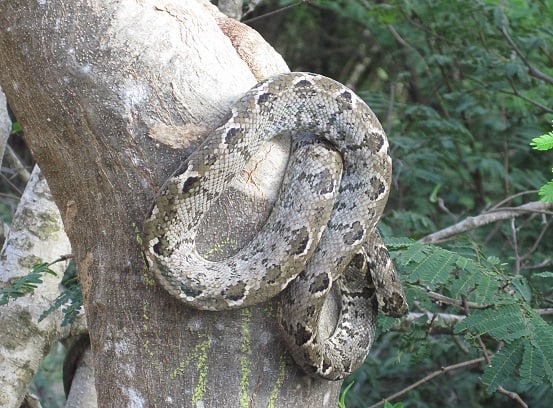
A highly flexible snake that only needs a tree and little else. They can cling to trees outside hotels, by banana plantations, and most definitely in your garden. Grenada tree boas inhabit their namesake island and reach 188cm. They belong to the same family as the Amazon tree boas, and are non-venomous constrictors. They prey on rodents, so they won’t solve your slug problem, but they may solve your rat problem.
Grenada tree boas are common in rural gardens on this Caribbean island, where they can lurk silently on a tree for hours, usually disguised by overlapping branches. Though thick and long, they could still catch you unawares, hissing and lunging, forcing you to drop your grass cuttings and head indoors.
If you live in an old mansion, a Grenada tree boa could easily live in your hedge maze, lurking around corners, making it twice as terrifying for the visitors lost in its winding passages. The garden might be so large that a Grenada tree boa lives there in peace and you never notice them. If you’re that rich, it would be your hired help that gets terrified and not you, unless they manage to enter the plumbing and attack you via your golden toilet.
| 9 | Red-lipped snake |
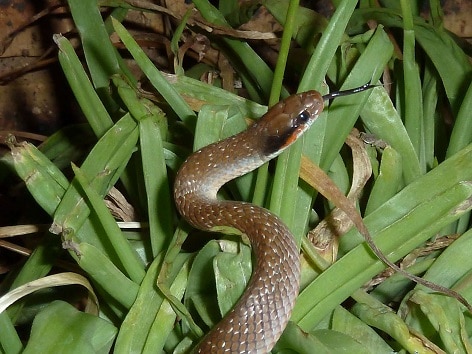
A common snake in suburban areas of South Africa. If your garden backs onto a desolate canyon, the red-lipped snake won’t turn up. But if it’s a traditional flowery garden with vegetables and a pond, expect this easily recognisable snake possibly several times per year.
Red-lipped snakes like moister areas than many South African snakes, including forests, marshes, and people’s gardens. Toads are one reason – red-lipped snakes have the power to swallow huge ones, and rain frogs are one confirmed prey. They can track them using lingering scent molecules, so a garden full of amphibians is a great way to attract them.
Red-lipped snakes stick to the ground, so be careful when rummaging around, maybe after dropping your keys. What happens if you pull out your hand to find a red-lipped snake chewing it? You’ll live, but your hand may swell painfully. Its venom is much more mysterious than its diet, and they aren’t hellbent on biting people anyway. Red-lipped snakes inhabit most of sub-Saharan Africa, particularly along the east coast.
| 10 | Hudson’s coffee snake |
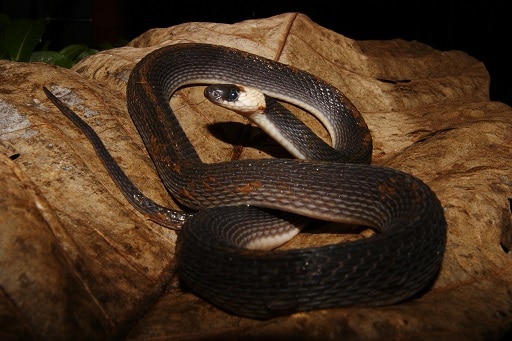
An Ecuadorian species, with no venom and an average length of 40-50cm. Hudson’s coffee snakes are very timid and normally shield their brain in their coils when picked up. On the eastern slopes of the Andes, you have a strong chance of meeting them, as while they prefer evergreen forests, they’re also plentiful in gardens and pastures.
Hudson’s coffee snakes stick to the ground rather than climbing trees, so you may find them under assorted objects. It’s possible that they’re hiding in your garden to avoid coral snakes, as Hemprich’s coral snake is one of their confirmed predators. Rather than a curse, this species is a blessing. Hudson’s coffee snake eats worms and grubs that nibble at your produce, increasing the yield, preventing rotten and useless ones, whether it’s strawberries or tomatoes.
If you want to own the most productive, vibrant garden in town, then a Hudson’s coffee snake is the way to achieve it – maybe 5 or 6. If you hold your nerve, and accept that a snake colony lives right outside your backdoor, they could turn you into a master gardener. You could even venture to your local woods, scoop one up, and give it a new home, although we don’t actually recommend this, as evidence shows that some snakes suffer when artificially relocated.
